Do Gutter Guards Work? Should I Invest?
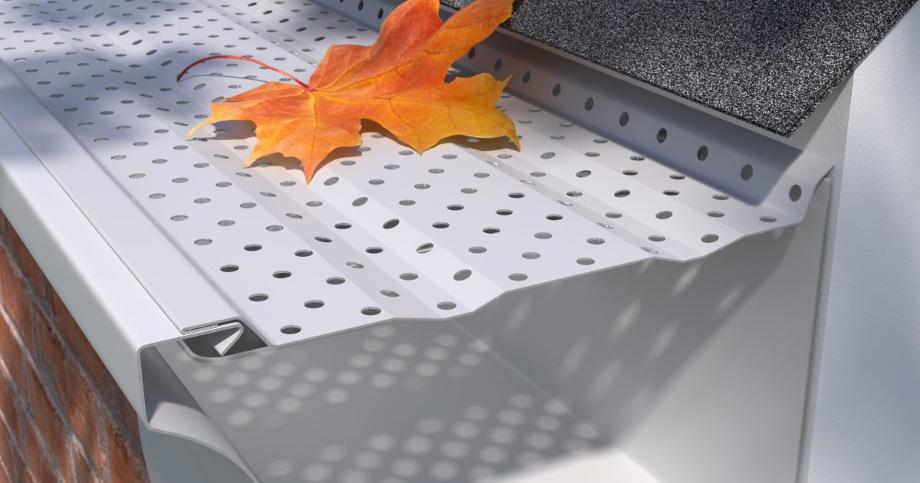
The entire purpose of gutters is to collect the rainwater that is shed from your roofing surface, redirect that water, and ultimately disperse it away from your home’s foundation. This process prevents dirty roofing water from running down the sides of your home and/or splashing down onto the ground eventually eroding the soil around your home’s supportive foundation. Therefore, the effectiveness of gutter guards is often disputed, and so the question remains, do gutter guards work? The short answer is yes, but the long answer is that it depends on the type of gutter guard that you are having installed onto your gutters and your overall expectations.
Do you expect your gutters to collect water during heavy rainstorms effectively or are you okay with some water splashing over the top of your gutters. Some gutter guards are more effective than others when it comes to keeping debris out of the inside of gutters which does prevent internal clogging very well. Unfortunately, this usually comes at the cost of restricting the water flow entering the gutter system.
Gutter guards, gutter covers, leaf guards, leaf filters, leaf protection covers, gutter helmets, gutter hoods, among many others, are all names used to represent the guards or covers that affix to the top of your gutters and designed to prevent gutters from clogging. There are many styles of gutter guards on the market, each with their own unique ways of filtering solid debris out of gutter systems while still allowing water to be collected into the gutter trough. This is where the performance of the various gutter guards differs. Our objective is to provide you with information on the different gutter guards available on the market, so you can make an informed decision on which style works best for your home and what you can expect from the product. We will discuss the most common, reliable, and controversial gutter guard types, highlighting their pros and cons. In case we do not cover a particular type or product, such as PVC or Snap-on gutter screens, it is safe to assume that the product is not worth mentioning and not worth your investment.
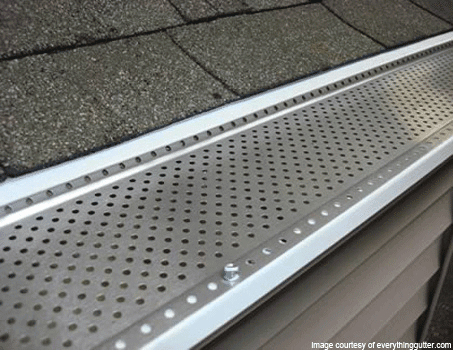
Do Gutter Guards Work, What to Consider: Cost, Effectiveness/Performance, & Maintenance
Cost - When considering the installation of gutter guards, it is important to keep in mind their cost effectiveness. If you only need to have your gutters cleaned once a year or every few years, gutter covers may not be the most economical choice for you. However, if your home requires two or three cleanings annually, installing gutter covers can be beneficial and cost-effective in the long run.
Effectiveness and Performance - An additional factor to ponder is whether the type of gutter guards that you are considering will cause rainwater to flow directly over the gutter, instead of collecting inside of the gutter trough, bypassing the gutter system altogether. If you are currently experiencing issues with water spilling over your gutters in certain locations, installing gutter covers probably will not resolve the problem. In fact, in areas with high water volume such as beneath roof valleys where multiple roof sections meet, certain types of gutter guards may exacerbate the issue by causing even more water to spill over the gutter systems.
Maintenance - Gutter Guards or leaf protection systems are never maintenance-free. They are only necessary in areas with heavy tree coverage, and different types/style products require varying levels of maintenance. The right leaf protection system will significantly reduce the need for annual gutter cleaning. However, if your home does not require multiple gutter cleanings per year due to a lack of tree coverage, installing gutter covers or leaf protection may not be worth the investment. For some, it may be more cost-effective to hire professionals to clean accumulated debris from gutters when needed. Ultimately, each situation is unique, and it's up to the individual to decide if investing in gutter guards or leaf protection is worth the peace of mind.
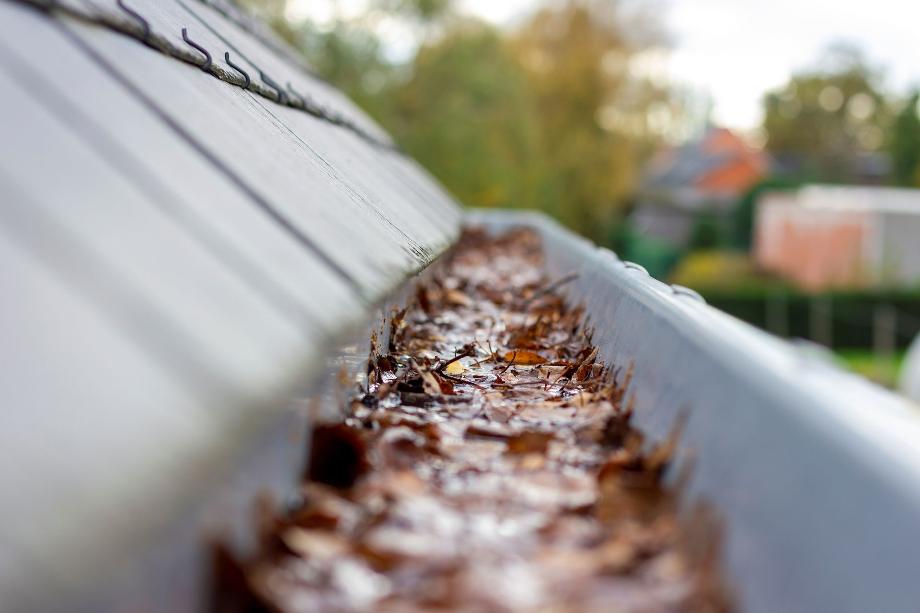
Leaf Guards, Gutter Helmets, & Reverse Curved Gutter Guards:
Leaf guards or gutter helmets also known as reverse curved gutter guards, are a type of gutter cover that is designed with a solid hood and a curved shaped rim to allow water to enter the gutter trough. They are sometimes referred to as leaf guards, gutter helmets, solid gutter guards, or gutter hoods. These guards consist of a single sheet of aluminum that caps over the gutter and extends to cover the top of the gutter. Some of these guards can be challenging to install because they often require being tucked under the shingles of the roof, which can cause shingles to bulge or “ski slope” if the fit is not precise. This requires a lengthened installation process and increases the overall cost. The installation process where gutter helmets or hoods are tucked under the shingles most often VOID the shingle warranty even if you have purchased an extended warranty for your roof.
Numerous brands produce leaf guards, gutter helmets, solid gutter guards, or hoods, and promote various assurances to justify the high price of installing them onto your house. However, it has been previously mentioned that no gutter cover or leaf protection mechanism is entirely maintenance-free. These companies are aware that they will eventually have to revisit to unclog or remove debris from their gutter system. This is one of the reasons why their services are costly since they must account for future follow-up visits in their initial pricing.
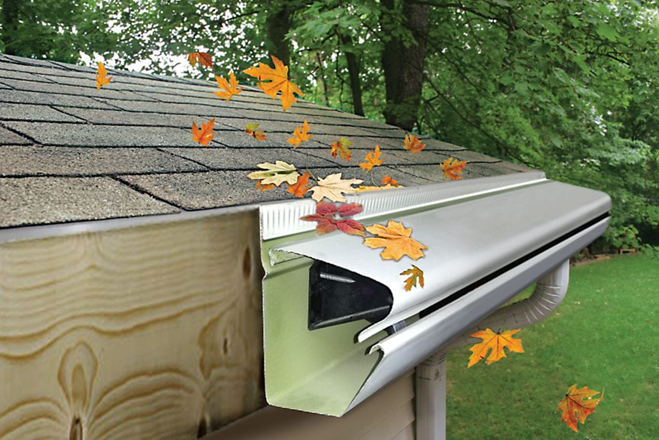
Do leaf guards, gutter helmets, or reverse curved gutter guards work?
Leaf guards and gutter helmets are frequently marketed as the most effective solution to reduce the need for regular gutter cleaning. While this is partially true, it comes with a major downside. During moderate to heavy rains these guards very often cause water to cascade over the tops of gutters and create waterfalls around your home. This is also the case for roofs that have steep pitches defeating the entire purpose of having gutters in the first place, which is to collect rainwater and divert the water away from the home thus preventing water from damaging your home and its foundation. In essence, if the water is not going into the gutter system, the guards render the entire system useless, and you're essentially wasting money.
How much do leaf guards, gutter helmets, or reverse curved gutter guards’ cost?
The price of Leaf Guards or Gutter Helmets per foot can vary between $20 to $40 per linear foot when installed. This type of gutter cover is much more expensive compared to our recommended style (perforated aluminum gutter guards) which costs $8 to $10 per linear foot installed. Homeowners can expect to pay around $4k to $8k for professional installation of reverse curved leaf guards or gutter helmets, considering that an average home has approximately 200 feet of gutter. Estimates over $10k for these type of gutter guard systems is not uncommon. The wide range in cost can be attributed to the numerous corporations that offer their own patented brands of reverse curved leaf guards or gutter helmets.
Do leaf guards, gutter helmets, or reverse curved gutter guards work in heavy rain?
During heavy rain, reverse curved leaf guards or Gutter Helmets very often experience overflow and splash over. This can lead to pooling and flooding around the house foundation in severe cases. These guards are not suitable for use with steep metal or slate roofs, as these types of roofs shed rainwater at a much faster rate compared to traditional asphalt shingles. Similarly, homes with steep shingle roofs may experience the same issues. Installation of splash guards, valley guards, or water diverters in the corners below roofing valleys is necessary to help reduce the splash over effect. However, some people may find these guards aesthetically unpleasant. Additionally, leaf guards are visible from the ground, which may affect the overall appearance of the gutter system.
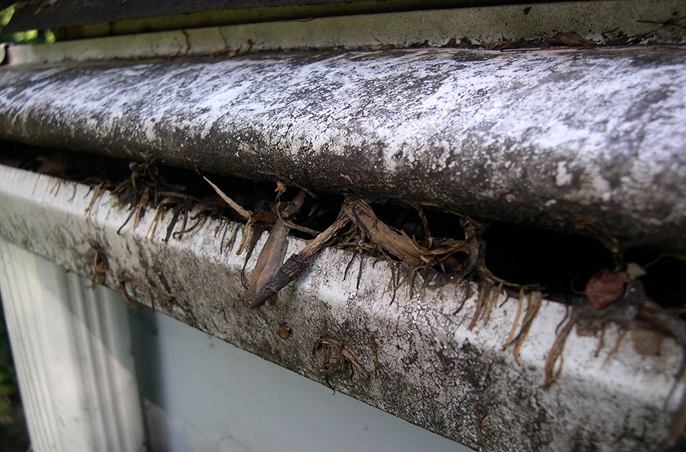
Are leaf guards, gutter helmets, or reverse curved gutter guards worth the investment?
The most expensive type of gutter covers on the market are leaf guards, gutter helmets, aka reverse curved gutter guards. Although they effectively prevent debris buildup inside of the gutters, they also keep a significant amount of water out. Their high cost is not justifiable since they work against the primary function of gutters, which is to collect rainwater and to disperse that water away from the structural foundation of your home.
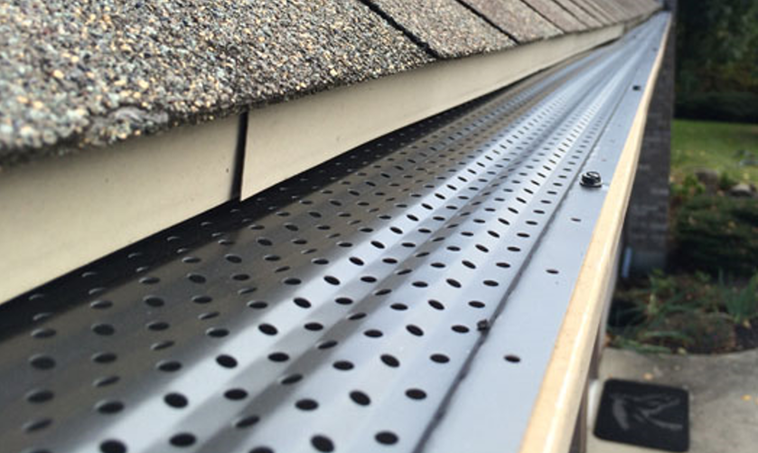
Perforated Aluminum Gutter Guards:
Ed Callaway, owner of Golden Hammer Gutters, highly recommends the use of Perforated Aluminum Gutter Guards or Leaf Guards as a Leaf Protection solution for all roof types. These products are reasonably priced and come with manufacturer warranties ranging from 10 to 25 years, ensuring that they are both effective and reliable. The perforated hoods of these Gutter Guards allow for high volumes of water to enter the gutter trough quickly, making them ideal for heavy rainstorms. Additionally, their smooth design allows leaves and other debris to be easily blown off the hoods with a light breeze.
How much do Perforated Aluminum Gutter Guards cost?
The installation of Perforated Aluminum Gutter Guards or Leaf Guards typically involves a cost ranging from $8 to $10 per linear foot. On average, a typical home may require around 200 feet of gutter installation. Consequently, homeowners should anticipate spending between $1,600 and $2,000 for professional installation of Perforated Aluminum Gutter Guards. This cost will often include the removal of the existing debris inside of the gutter and downspout systems.
Do Perforated Aluminum Gutter Guards really work?
Perforated Aluminum Gutter Guards are very effective in their purpose because they effectively prevent internal clogging without restricting water flow. Most importantly they perform very well with heavy volumes of water during rainstorms. They work well with all roof slopes/types including metal, tile, and slate. Perforated Aluminum Gutter Guards also have a smooth surface which helps prevent excessive accumulation on top of the gutter guards themselves. Light wind or breeze can easily blow dry and loose debris from on top of the Gutter Guard surfaces. They possess high durability and can withstand heavy build-up on top including accumulated leaves, debris, snow, and ice. However, it is not recommended to allow buildup to accumulate as it restricts water flow and reduces the product’s effectiveness.
Do Perforated Aluminum Gutter Guards cause any problems?
Just like most other leaf protection systems, Perforated Aluminum Gutter Guards require splash guards at the bottom of long or steep roofing valleys to prevent splashing over during heavy rains. However, debris can accumulate behind these splash guards over time, requiring removal from areas where it has accumulated on top of the hoods. As water enters the gutter trough through the perforated holes in this gutter cover type, it is critical to prevent debris from accumulating on the roofing surfaces or on top of the gutter guard hoods. We recommend having your roof blown off every few years and sweeping the tops of the perforated hoods clean to maintain optimal performance.
Are Perforated Aluminum Gutter Guards worth the investment?
The Perforated Aluminum Gutter Guards style are worth the investment because they block the vast majority of small debris and all large debris from entering the gutter trough while still allowing high volumes of water to flow through during heavy rainfall. Regular gutter cleaning maintenance will be significantly reduced with the installation of Perforated Aluminum Gutter Covers. The accumulation of debris inside the gutter trough will be prevented as the product will not allow any debris to enter. It is important to avoid allowing debris to gather on top of the roofing surface or the gutter hoods as it will eventually hinder water flow. Additionally, this product is not visible from the ground and does not create an unsightly view. Perforated Aluminum Gutter Guards also have a very reasonable ROI (Return on Investment), especially if your home requires multiple gutter cleanings per year in order to maintain your gutter systems functionality.
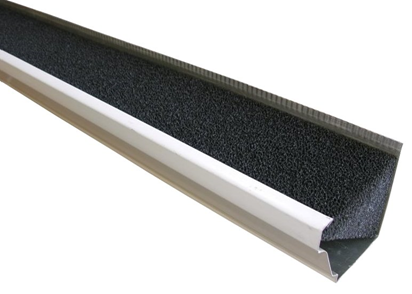
Gutter Filter Foam Inserts:
The Gutter Filter Foam inserts have the ability to handle large amounts of rain and are suitable for all roofing types. Although not noticeable from ground level upon initial installation, we strongly advise against using this form of leaf protection. Due to various issues surrounding this product, we will delve into its controversial nature further.
Do Gutter Filter Foam Inserts work?
The Gutter Filter Foam has proven to be highly inefficient and unreliable. While it may seem like a cost-effective option at first, it fails to withstand the test of time. In many cases, the product begins it deterioration after only a few years, shrinking and crumbling with use. The design of the foam is intended to let water pass through it while blocking debris such as leaves from entering the gutter system. However, the foam's rough surface traps a significant number of debris, causing them to accumulate on top of the foam and trap inside of the foam, which effectively impedes the water flow. Over time, this buildup causes the trapped debris to decompose and create blockages on the surface of the foam. The trapped debris are very challenging to remove from inside of the foam which makes cleaning the foam inserts virtually impossible.
How much do gutter filter foam inserts cost?
The typical expense for Gutter Filter Foam Inserts, inclusive of installation, is around $7.50 to $10 per foot. Assuming a standard home has roughly 200 feet of gutter, homeowners can anticipate a total cost of approximately $1,500 to $2,000 for the installation of Gutter Filter Foam Inserts by a professional.
Do gutter filter foam inserts cause problems?
Over time, Gutter Filter Foam Inserts facilitate the growth of plants. As debris accumulates on the foam's surface, it decomposes and forms compost-style soil that fills the filter. This soil is challenging to remove and clean, resulting in trapped dirt. Consequently, vegetation grows inside the gutter system, with root systems spreading throughout the soil-filled filter. Due to the constant flow of rainwater through the gutters, these small plants grow steadily.
Are Gutter Filter Foam Inserts worth the investment?
The removal of Gutter Foam Filters after installation is a difficult task due to the natural elements such as sunlight that cause the foam to harden and become brittle. Moreover, as a petroleum-based product, these foam filters attract other petroleum-based substances, including roofing oils from asphalt shingles. Consequently, the foam filters need to be removed and cleaned thoroughly once they trap oil, dirt, and soil. This task is arduous and best handled by a professional gutter cleaning service, which makes it an expensive undertaking. Ultimately, the product fails to minimize your regular gutter cleaning maintenance but rather complicates the process.
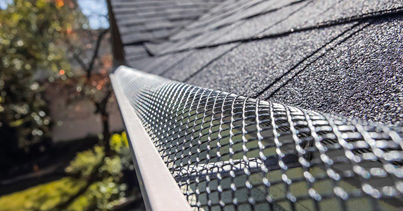
Vinyl & Metal Gutter Screens:
Gutter Screens are available in an extensive range of styles, materials, and colors. Vinyl plastic is a popular option that comes in limited colors such as white, black, and brown. However, additional colors can be found online from some manufacturers. Moreover, high-quality metal Gutter Screens are also available with various design options. They come in Aluminum and galvanized steel. Additionally, they are coated in black rubber to enhance their durability and longevity.
Do Vinyl & Metal Gutter Screens work?
Although not particularly sturdy, Gutter Screens are compatible with all types of roofs and can manage substantial amounts of water during intense rainstorms. They perform adequately in preventing downspout blockages between regular gutter maintenance, but unfortunately, they cannot diminish the frequency of such maintenance. While Gutter Screens prevent bulky leaves from entering the gutter channel, they still permit smaller debris to pass through, thereby necessitating the regular cleaning of the accumulated debris. Due to their ruggedness, Gutter Screens cause debris to catch and accumulate on top of the screens. Helicopter seeds and pine needles regularly get stuck in Gutter Screens and will also accumulate inside of the gutter trough.
How much do Vinyl & Metal Gutter Screens cost?
The typical expense for installing Vinyl & Metal Gutter Screens is around $4 to $7 per linear foot. Plastic Gutter Screens are an affordable option to shield your gutter system from leaves. Metal gutter screens incur a higher cost in comparison to their vinyl plastic counterparts due to material expenses and lengthier installation time. However, metal gutter screens are more durable than their vinyl plastic counterparts and will last longer.
Do Vinyl & Metal Gutter Screens cause problems?
The durability of this type of leaf protection is a significant drawback. Gutter screens made of vinyl plastic will not last for an extended period. Over time, they will warp and twist due to temperature changes and natural elements such as the sun. When removing them to clear debris from inside the gutters, they may become brittle and eventually crack. Additionally, leaves, debris, snow, and ice accumulations will cause the vinyl plastic screens to sag and cave in because they are not very durable.

Which is better Vinyl & Metal Gutter Screens?
Aluminum and metal gutter screens are more durable and longer lasting than vinyl plastic gutter screens. They are screwed in place and can withstand leaves, debris, snow, and ice accumulations better than their vinyl plastic counterparts, although they are a bit more costly. They also become bent and twisted over time due to the need to remove and reinstall them for gutter cleaning, similar to vinyl plastic gutter screens.
Are Vinyl & Metal Gutter Screens worth the investment?
Gutter Screens are widely used due to their relatively low cost. We suggest using them only If you want to avoid downspout clogs in between regular gutter cleaning maintenance. However, it's important to note that Gutter Screens do not reduce the need for regular cleaning. This style of leaf protection still allows debris to accumulate and eventually clog your gutter system.

Leaf Filters or Plastic Micro Mesh Gutter Screens:
There are varying types of leaf filters and Plastic Micro Mesh Gutter Screens, each with varying levels of quality. The inferior Plastic Micro Mesh Gutter Screens are made of pliable vinyl plastic with a delicate mesh fabric that is adhered to the top. This adhesive tends to rapidly deteriorate, leading to separation between the plastic and cloth. On the other hand, the superior leaf filters possess a firmer plastic housing with a metallic mesh screen insert. Local hardware stores typically sell the lesser quality micro mesh Gutter Screens, while the higher quality leaf filters are exclusively obtainable through authorized dealers. Typically, large corporations own and patent leaf filter style products.
Do Leaf Filters or Plastic Micro Mesh Gutter Screens work?
With holes as small as 50 microns in diameter, leaf filter gutter screens allow only the smallest particles to enter the gutter system. This design prevents small shingle particles and debris from getting inside of the gutters, but over time, they can experience sludge buildup that requires tedious manual removal. This sludge buildup can be caused by heavy pollen, dirt, shingle grit, various debris, mixed with roofing oils, and tree sap which will eventually restrict water flow into the gutter systems. When this happens, water can overflow from the gutters, run down the sides of the house, and erode the soil around the home’s structural foundation. To prevent this, the metallic micro mesh in the leaf filters must be cleaned periodically to allow water to flow through without restriction.
The plastic Micro Mesh Gutter Screens can easily manage large amounts of water during intense rainstorms and are compatible with all types of roofs. They are effective in preventing downspout clogs in between regular gutter cleaning maintenance. However, they do not decrease the frequency of regular gutter cleaning maintenance. The mesh cloth of the Micro Mesh Gutter Screens quickly detaches from the plastic, resulting in a short lifespan. Additionally, the plastic screens become warped and twisted over time, making reinstallation after gutter cleaning challenging and time consuming.
How much do Leaf Filters or Plastic Micro Mesh Gutter Screens cost?
On average, the cost for materials and installation of Leaf Filters gutter guards is between $17 and $43 per foot. For a home with 200 linear feet of gutters, the cost for professional installation of Leaf Filter gutter protection ranges from $3,400 to $8,600.
Are Leaf Filters or Plastic Micro Mesh Gutter Screens worth the investment?
Due to the very high price point the ROI (Return on Investment) is not very good. For most homeowners it will take a very long time to see any return on investment for these style gutter guards. Considering the overall performance, maintenance, and cost effectiveness, we do not recommend these types of products. Micro-mesh gutter screens have small holes with a diameter as little as 50 microns, which only allow small particles to pass through and prevents even tiny shingle particles from entering the gutters. However, over time, sludge can accumulate on top of the leaf filters, necessitating manual removal periodically. Otherwise, water will not enter the gutters, creating a problem. As previously stated, there is no Gutter Cover or leaf protection system that will be maintenance-free indefinitely, and corporations make big promises and charge a premium to install these products, but they know that these problems will eventually arise.
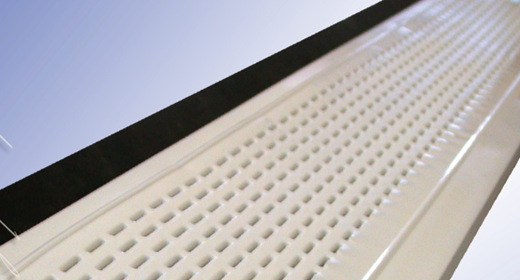
Do Gutter Guards Work? Should I Invest? - Key Takeaways
Investing in perforated aluminum gutter guards can be a wise decision for your home because Perforated Aluminum Gutter Guards have a very reasonable ROI (Return on Investment), especially if your home requires multiple gutter cleanings per year in order to maintain your gutter systems functionality. This style of gutter guards can reduce expenses on gutter cleaning and repairs while preventing water damage to your property. Nonetheless, they should not be perceived as the ultimate solution because you must still conduct periodic maintenance on your roofing and gutters. Perforated aluminum gutter guards will practically eliminate the need to clean out the gutter systems internally as they do a fantastic job at preventing internal clogging. However, it is still required to have the debris blown off your roofing surfaces and from on top of the gutter guard surfaces every couple of years or as needed to maintain optimal performance. It is crucial to perform thorough research when selecting gutter guards and opt for a durable product that can withstand the test of time. Golden Hammer Gutters recommends Perforated Aluminum Gutter Guards. Call today and we will help you pick the best brand.